立命館大学人間科学研究所主催
オープン・リサーチ・センター整備事業「臨床人間科学の構築」公開報告会と記念講演
2008年3月7日(金)9:30~17:30
立命館大学衣笠キャンパス 創思館1Fカンファレンスルーム
バリアフリーチームから考える『対人援助学』
錯視の研究
2008年3月6日より
バリアフリーチームの目標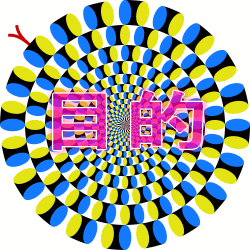 は、生活環境場面における各種のデザイン(単に対象の使いやすさだけではなく、建築・インテリア・衣装・情報媒体などにおける各種感覚・知覚・認知的なクオリティも含む)の改善に貢献することにより、(意識されない形で)対人援助を行なうことである。
は、生活環境場面における各種のデザイン(単に対象の使いやすさだけではなく、建築・インテリア・衣装・情報媒体などにおける各種感覚・知覚・認知的なクオリティも含む)の改善に貢献することにより、(意識されない形で)対人援助を行なうことである。
北岡明佳グループ(錯視研究)の経過報告(本日のメニュー)
(1) 輝度コントラスト依存の静止画が動いて見える錯視の研究
(2) 斜線が起こす静止画が動いて見える錯視の研究
(3) 何もしなくても動いて見える錯視の研究
(4) 錯視研究における新しい対人援助学的貢献について
東山篤規グループ、藤健一グループ、尾田正臣グループの報告については、ポスター発表をご覧下さい。

 バリアフリーの観点からは、各種のデザ
バリアフリーの観点からは、各種のデザ
インの中から錯視を取り除くことが望ましい。

(1) 輝度コントラスト依存の静止画が動いて見える錯視の研究
"Fluttering hearts"
Hearts appear to flutter. For those those who wear glasses, try to move them; then the hearts appear to move. For the majority, the hearts appear to be in front of the surface of white random dots when they are bright, while they appear to be behind it when they are dark.
Copyright Akiyoshi .Kitaoka 2006 (December 20)
References
Kitaoka, A. and Ashida, H. (2007) A variant of the anomalous motion illusion based upon contrast and visual latency. Perception, 36, 1019-1035.PDF
Kitaoka, A, Kuriki, I. and Ashida, H. (2006) The center-of-gravity model of chromostereopsis. Ritsumeikan Journal of Human Sciences, 11, 59-64. PDF
 Handout
the image shown above
Handout
the image shown above

輝度コントラストが低いと知覚の質が低下する(見づらい)ことの重要な要因として、輝度コントラストが低いと脳内処理時間が長くなることを、実験的に示した。このことは、色コントラストが強くて一見視認性のよいデザインでも、輝度コントラストが低いと知覚しづらくなる、ということを示している。
→ 色を多用する情報媒体のデザインにおいては、輝度コントラストにも細心の注意が必要である。
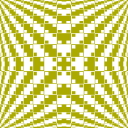
(2) 斜線が起こす静止画が動いて見える錯視の研究
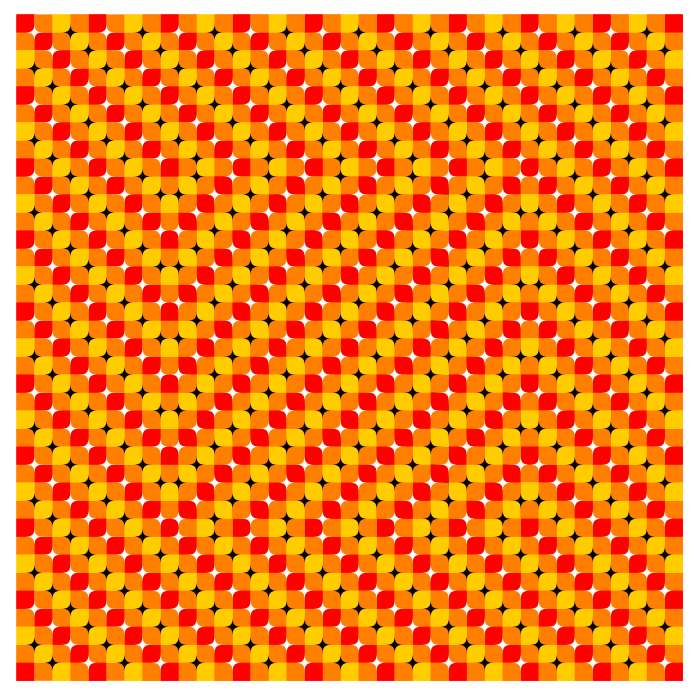
「秋の沼」
(再リメイク版)
中の正方形領域が動いて見える。
Copyright
A.Kitaoka 2000, 2003, 2007
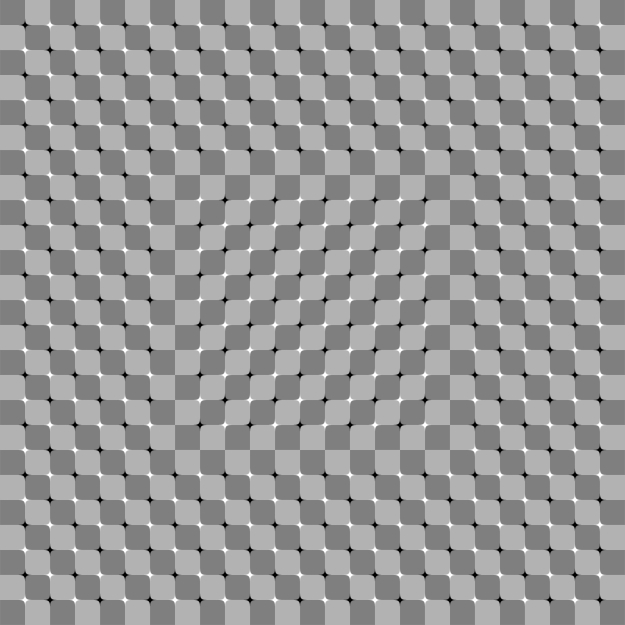
Illusion of Y-junctions
The inset appears to move according to retinal slips of the image. For example, the inset appears to slide leftward when upward retinal slip occurs; the inset appears to move upward when leftward retinal slip occurs. Moreover, there is a tilt illusion. For example, the vertical edges of the inset appear to tilt clockwise while the horizontal ones counterclockwise.
Kitaoka, A., Pinna, B., and Brelstaff, G. (2001). New variations of spiral illusions. Perception, 30, 637-646. PDF
Kitaoka, A., Pinna, B., and Brelstaff, G. (2004). Contrast polarities determine the direction of Cafe Wall tilts. Perception, 33, 11-20. PDF
Kitaoka, A. (2007) Tilt illusions after Oyama (1960): A review. Japanese Psychological Research, 49, 7-19. PDF
 Suggested underlying
mechanisms
Suggested underlying
mechanisms
1. Components of lower spatial frequency (given by wavelet transform?)
2. Components of tilt illusions (given by wavelet transform?)
1. Components of lower spatial frequency?
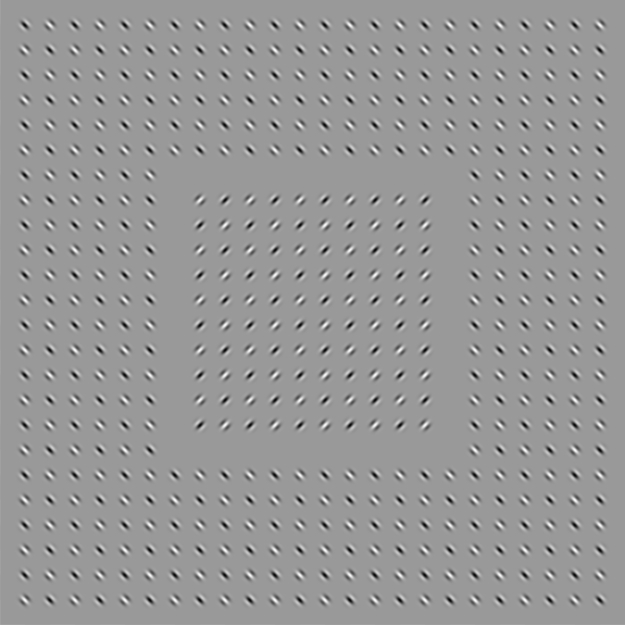
"Gabor patch drift illusion"
The inner square region appears to move. This is a translational representation of the Gurnsey-Morgan illusion.
Copyright Akiyoshi Kitaoka 2007 (August 6)
cf.
Gurnsey, R., Sally, S. L., Potechin, C., and Mancini, S. (2002) Optimising the Pinna-Brelstaff illusion Perception, 31, 1275-1280.
Morgan M, 2002 ``Running rings around the brain'' The Guardian Thursday, 24 January 2002; http://www.guardian.co.uk/Archive/Article/0,4273,4341518,00.html; http://www.staff.city.ac.uk/~morgan/TheWheel.pdf
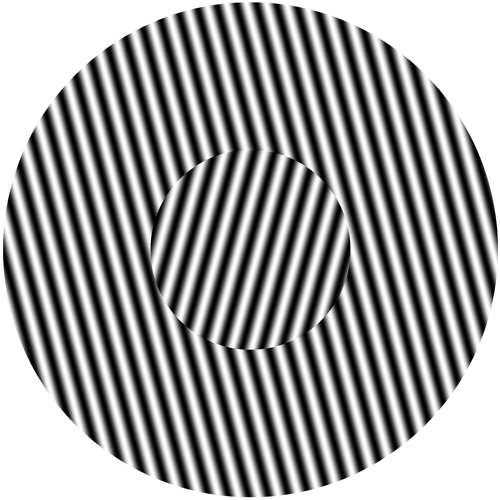
Hine illusion
Hine T J, Cook M, Rogers G T, 1995 “An illusion
of relative motion dependent upon spatial frequency and orientation” Vision
Research 35 3093-3102
Hine T J, Cook M, Rogers G T, 1997 “The
Ouchi illusion: an anomaly in the perception of rigid motion for limited spatial
frequencies and angles” Perception & Psychophysics 59
448-455
2. Components of tilt illusions?
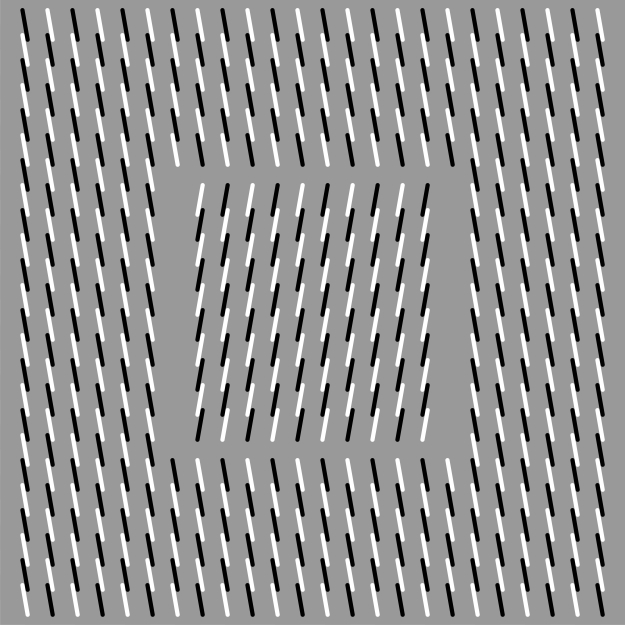
The inset appears to move horizontally when vertical retinal slips occur.
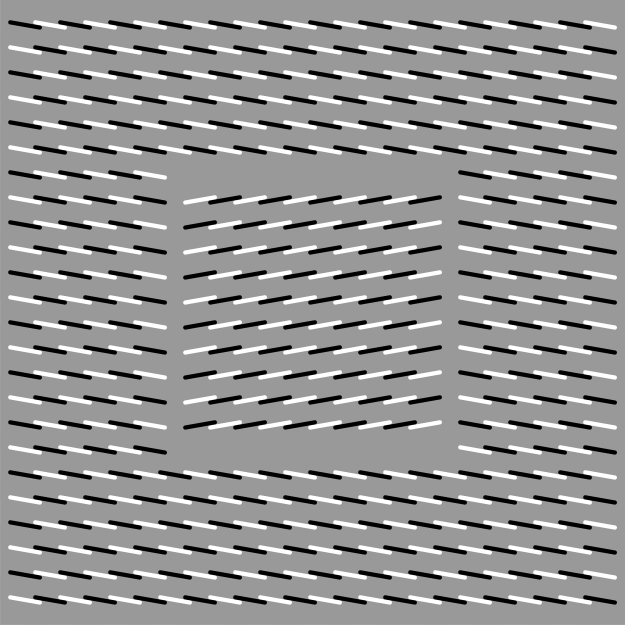
The inset appears to move vertically when horizontal retinal slips occur.
The illusion shown below can only be explained with mechanism 2

Illusion of fringed edges
The inset appears to move
leftward when an upward retinal slip occurs.
The inset appears to move
rightward when an downward retinal slip occurs.
The inset appears to move
upward when an rightward retinal slip occurs.
The inset appears to move
downward when an leftward retinal slip occurs.
The vertical edges of the
inset appears to tilt clockwise.
The horizontal edges of the inset appears to
tilt clockwise.
Newton Press (Ed.), A. Kitaoka
(Supervisor) (2007) Newton magazine
book: Special issue "How is the brain deceived? Perfect demonstration of visual
illusions" (published in
October 2007) ![]()
床屋のポールの錯視(barberpole illusion)
Kitaoka, A. and Murakami, I. (2007) Rotating Ouchi illusion. Poster presentation in VSS2007, Sarasota, Florida, USA, May 15, 2007. Abstract (MS-Word) VSS2007 Abstract (including all) (PDF)
(Kitaoka, A., & Murakami, I. (2007). Rotating Ouchi illusion [Abstract]. Journal of Vision, 7(9):984, 984a, http://journalofvision.org/7/9/984/,doi:10.1167/7.9.984.)

斜線が起こす静止画が動いて見える錯視の重要な要因として、斜線の空間周波数特性と、斜線と網膜像スリップの方向の成す角の組み合わせであることを示した。
→ 建築・内装等のデザインにおいては、できるだけ斜線を少なくするとともに、静止画が動いて見える錯視の発生しやすい刺激配置を避けることが必要である(たとえば、はっきりした長めの線分は、急な角度で交差させない)。
↓ たとえば、こういうデザインは避けた方がよい。
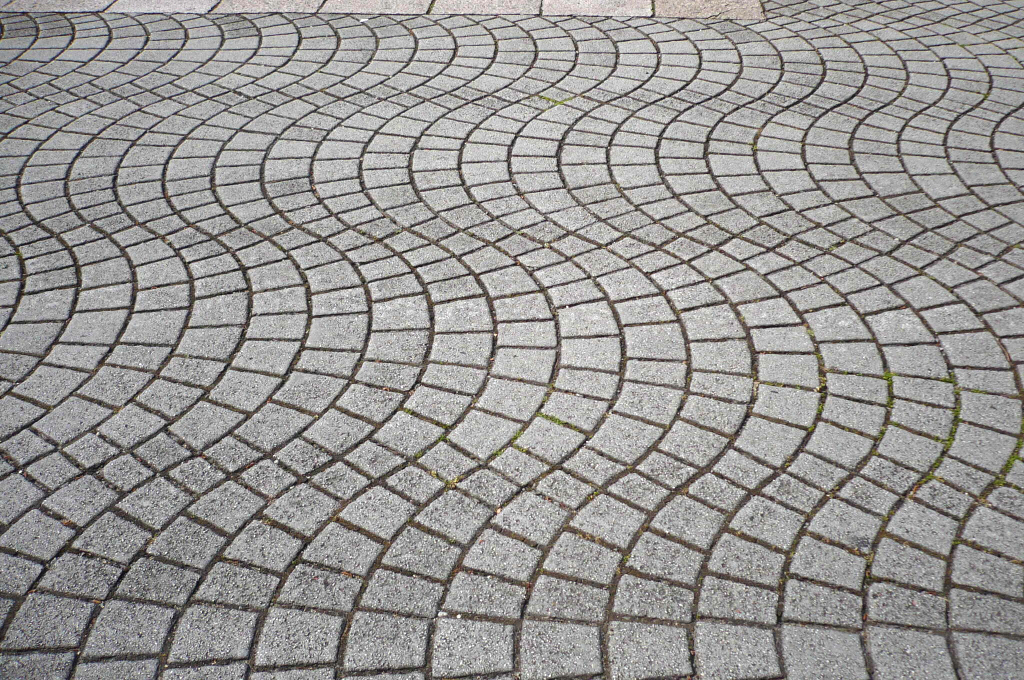
「平面の舗道が上下にうねって見えたり、動いてみえたりする錯視」
西宮市大谷記念美術館前だそうです。
Copyright HT 2007
from HT,Osaka, June 4,
2007
(3) 何もしなくても動いて見える錯視の研究
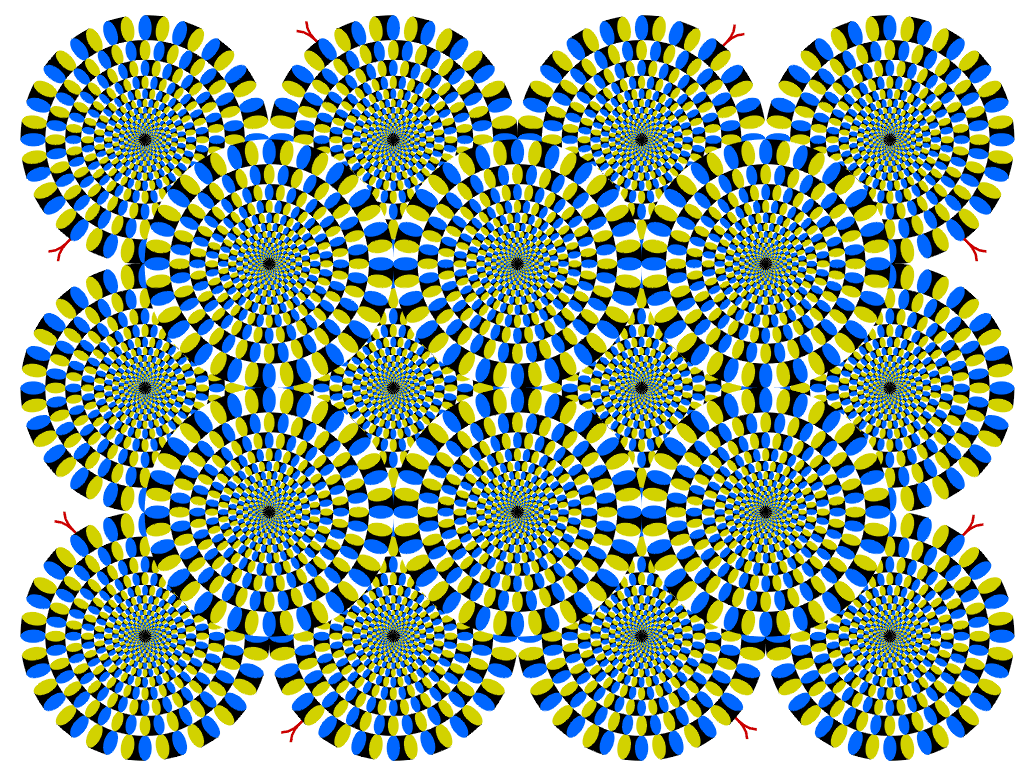
"Rotating snakes"
Circular snakes appear to rotate 'spontaneously'.
Copyright A.Kitaoka 2003 (September 2, 2003)
 Handout
the image shown above
Handout
the image shown above
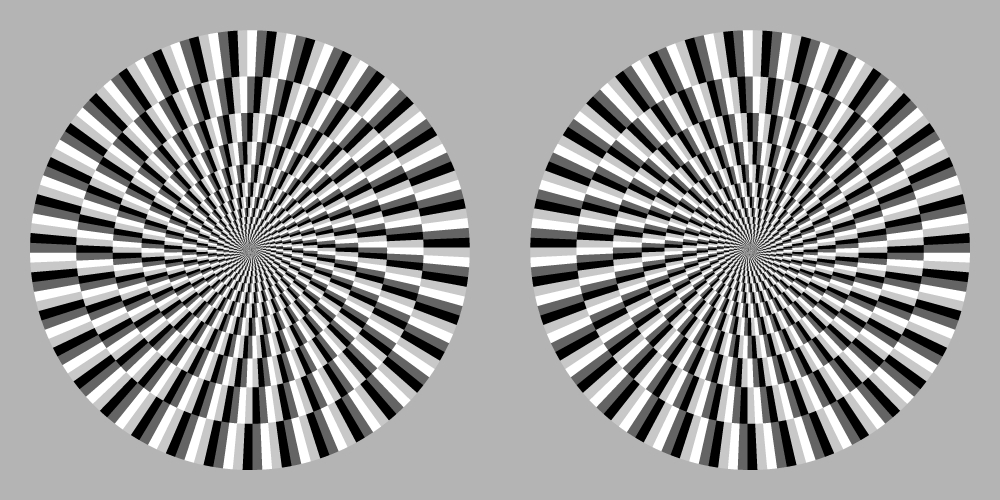
"Optimized Fraser-Wilcox" illusion
Kitaoka, A. and Ashida, H. (2003) Phenomenal characteristics of the peripheral drift illusion. VISION (Journal of the Vision Society of Japan), 15, 261-262. PDF
The direction of illusory motion
is:
Black -> dark gray -> white
-> light gray -> black
Tentative classification of this illusion
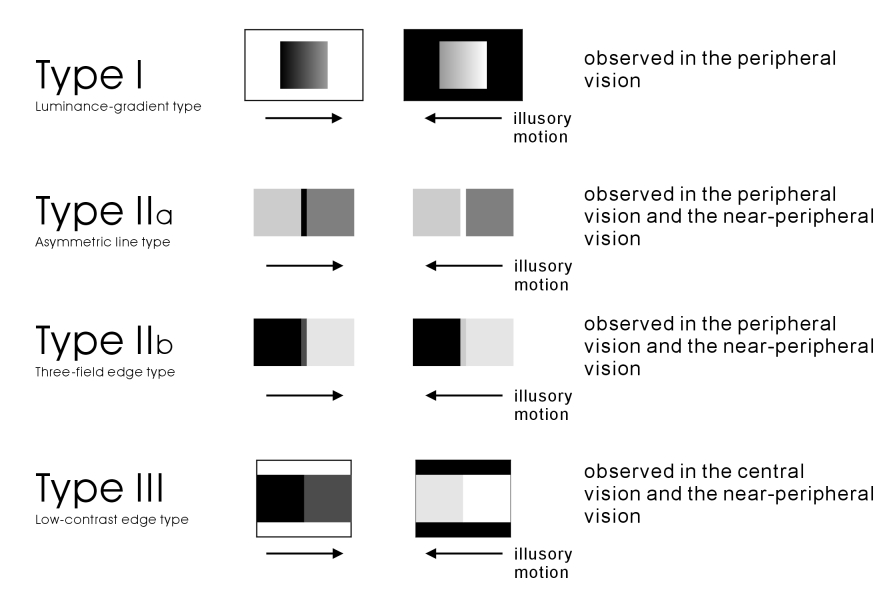
"Optimized Fraser-Wilcox" illusion, Type I
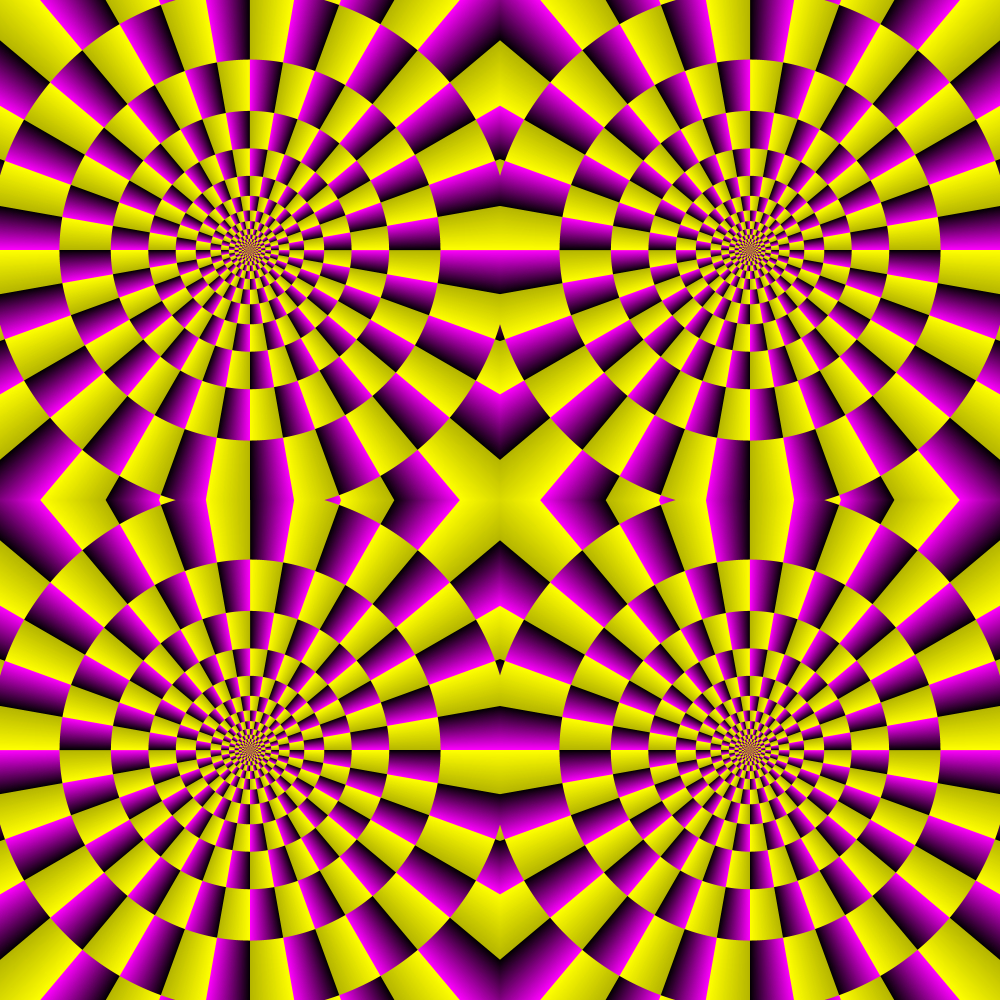
"The time tunnel show"
Rings appear to rotate.
Copyright Akiyoshi.Kitaoka 2006 (February24)
"Optimized Fraser-Wilcox" illusion, Type IIa
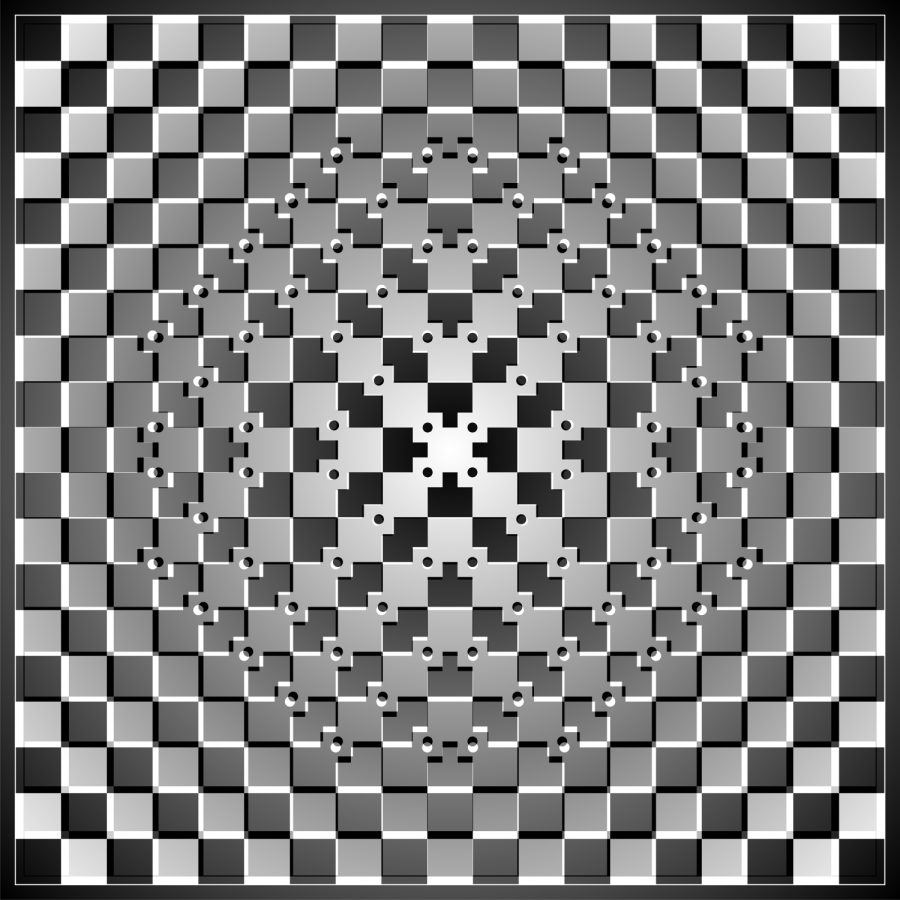
"Launch"
Something appears to be launched.
Copyright Akiyoshi Kitaoka 2008 (January 20)
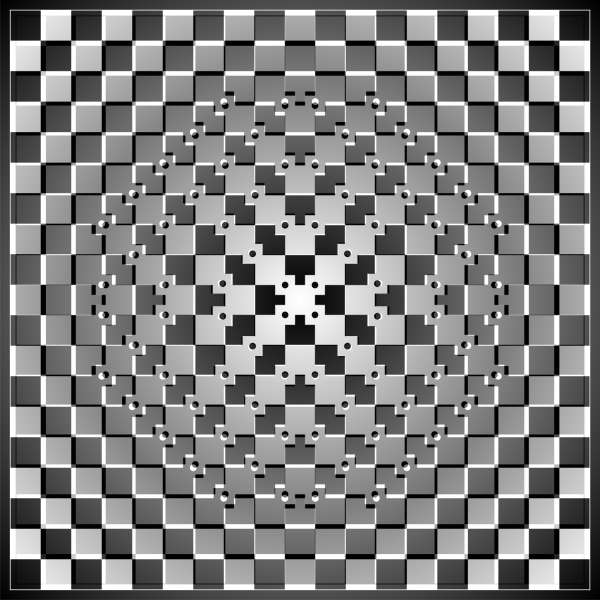
"Optimized Fraser-Wilcox" illusion, Type III
"Zig-zag worms"
The top and the third rows appear to move rightward while the rest appear to slide leftward.
Copyright Akiyoshi .Kitaoka 2007 (April 16)
Effects of color on the "optimized Fraser-Wilcox" illusion
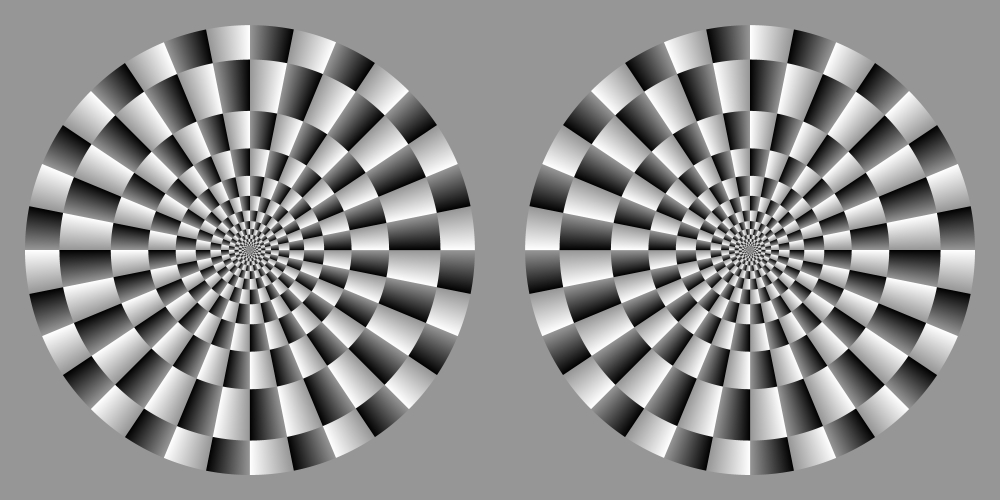
Black » Gray; White » Gray
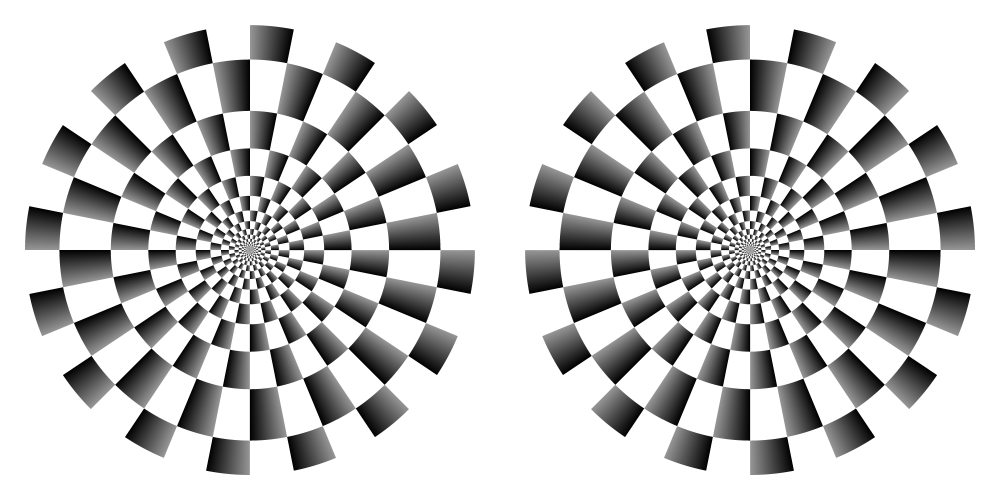
Black » Gray
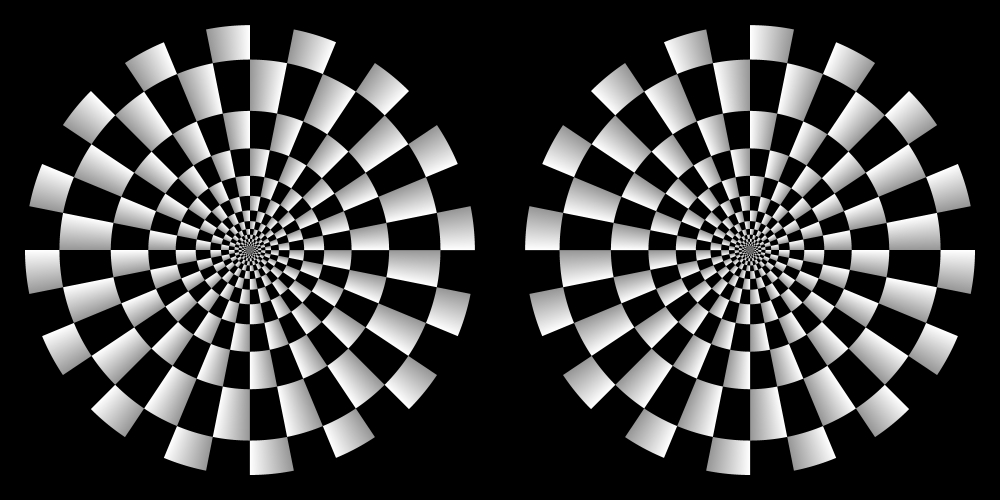
White » Gray
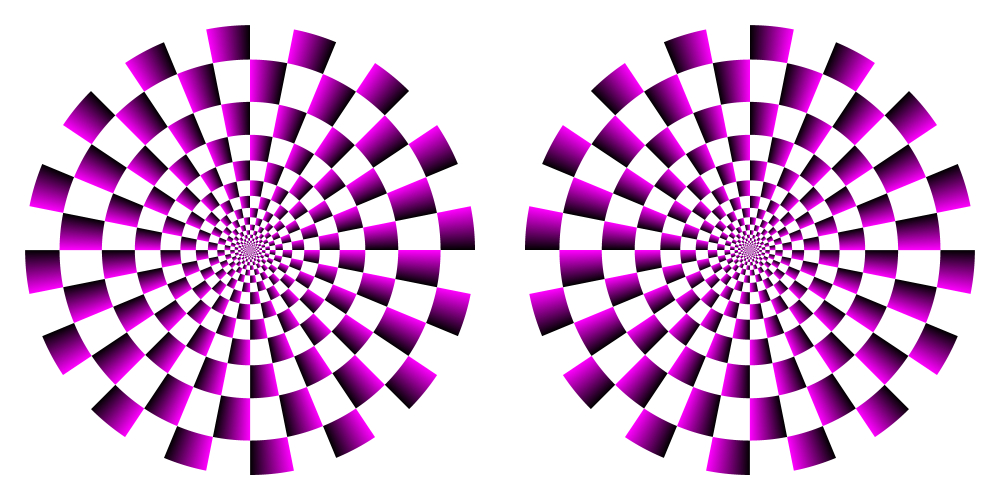
Black » Gray is replaced with Black » Magenta
Observation 1 The illusion from dark to light is enhanced by red or blue.
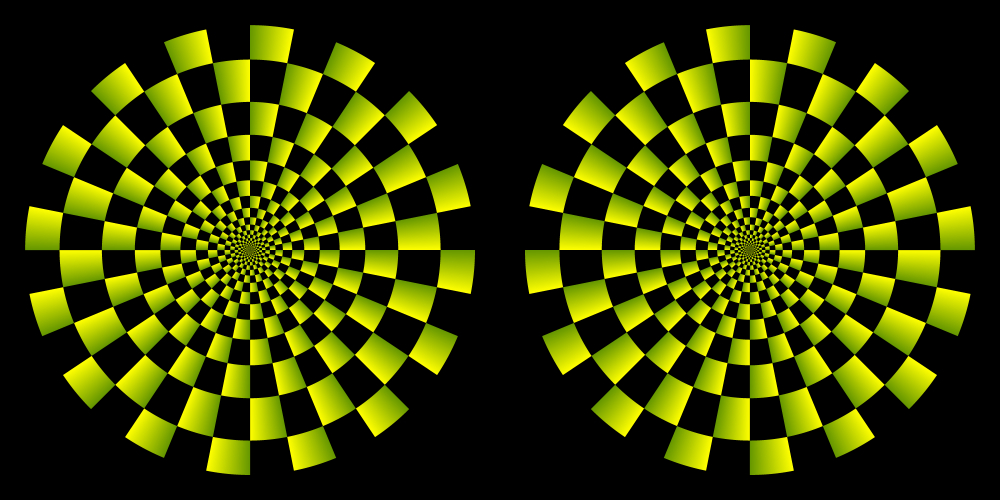
White » Gray is replaced with Yellow » Green
Observation 2 The illusion from light to dark is enhanced by yellow or green.
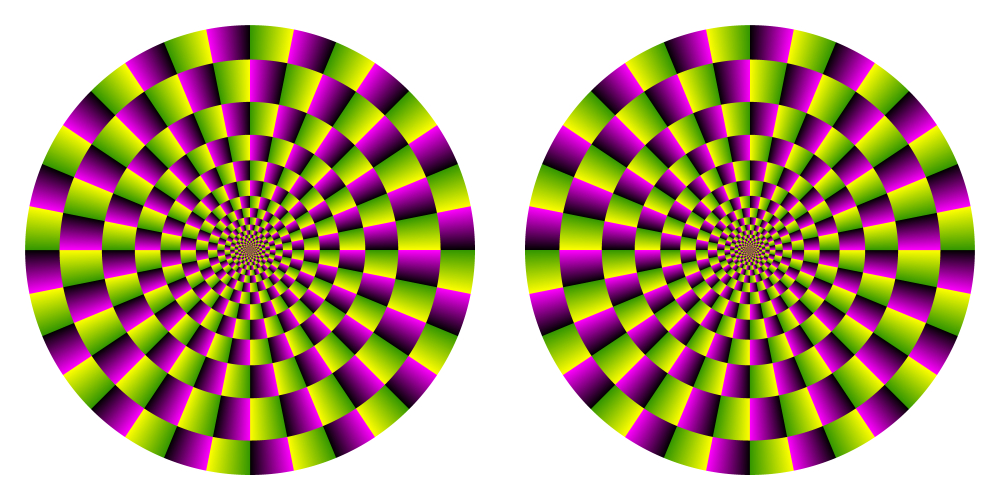
Black » Gray is replaced with Black » Magenta
White » Gray is replaced with Yellow » Green
Observation 3 The illusion from dark to light is enhanced by red or blue, and the illusion from light to dark is enhanced by yellow or green. Both illusions work additively.
 Suggested underlying
mechansims
Suggested underlying
mechansims
There are three explanations shown below.
Murakami, I., Kitaoka, A. and Ashida, H. (2006)
A positive correlation between fixation instability and the strength of illusory
motion in a static display. Vision Research, 46, 2421-2431. PDF
Backus, B. T. and Oruç, I, (2005) Illusory motion from
change over time in the response to contrast and luminance. Journal of
Vision, 5, 1055-1069. to get PDF
Conway, R. B., Kitaoka, A., Yazdanbakhsh, A., Pack, C.
C., and Livingstone, M. S. (2005) Neural basis for a powerful static motion
illusion. Journal of Neuroscience, 25, 5651-5656. PDF
 A plausible
explanation
A plausible
explanation
Parts of high contrast appear faster than those of low contrast, then "high-to-low".
高コントラスト領域が先に見え、低コントラスト領域が後で見えるとすれば、その方向に動いて見えるという考え方
ところが
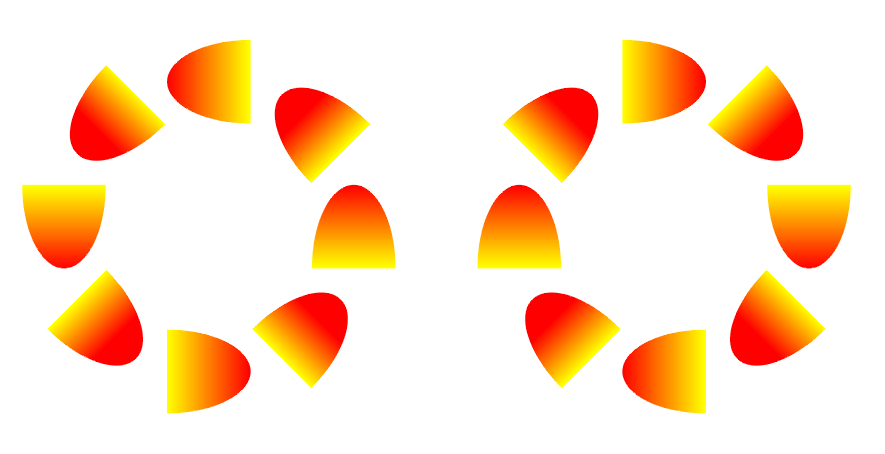
"Rotating carrots 2"
Rings of carrots appear to rotate slowly.
Copyright Akiyoshi.Kitaoka 2006 (February 17)

"Rotating sakura"
(a remake)
Rings made up of petals of cherry blossoms appear to rotate. The outer ring rotates counterclockwise while the inner one rotates clockwise.
Copyright Akiyoshi Kitaoka 2005 (January 26)
"Central drift illusion"
「中心ドリフト錯視」
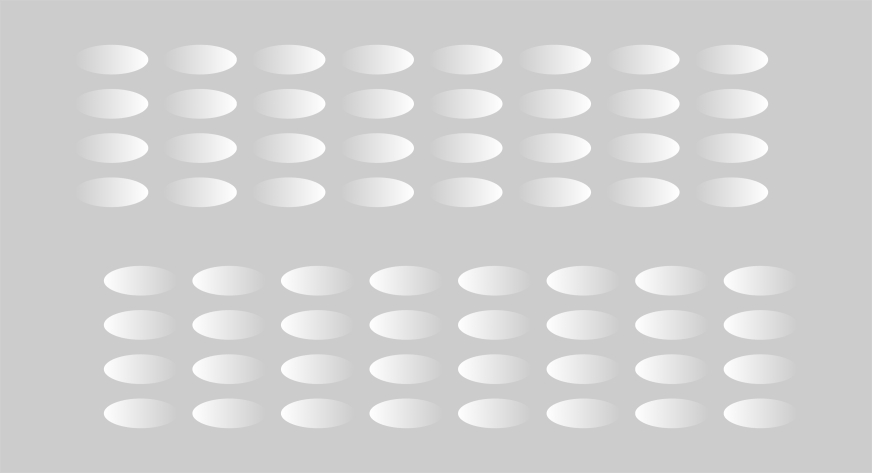
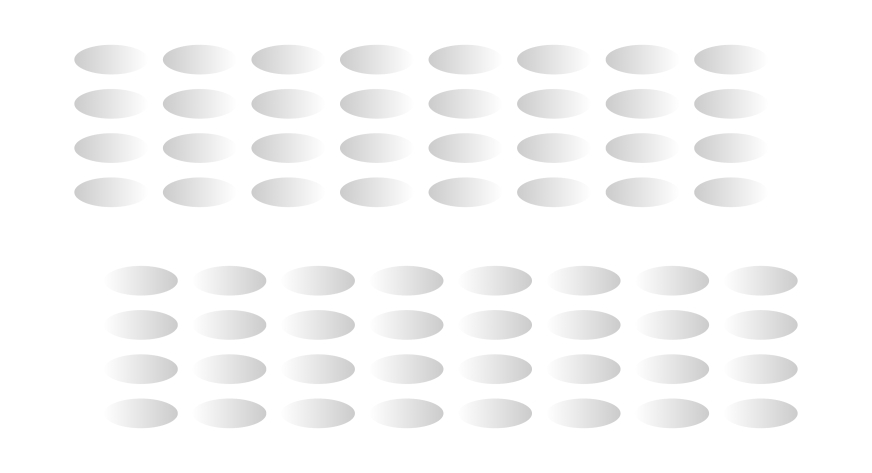
The direction of illusory motion is "low-to-high" in the central drift illusion.
中心ドリフト錯視では、錯視的動きの方向は、低コントラストから高コントラストの方向である。
Kitaoka, A. and Ashida, H. (2004) A new
anomalous motion illusion: the "central drift illusion". The 2004's winter meeting of the Vision Society
of Japan at the Kogakuin University, Shinjuku, Tokyo, Japan, 2004/1/26-28, 1/26 oral
publication. Presentation (html)
Individual differences in Rotating snakes
illusion
蛇の回転の個人差について
立命館大学・衣笠キャンパス・以学館5号教室において、付属校である(北海道の)立命館大学慶祥中学校1年生のご一行様に、北岡は「立命館で錯覚を研究する」というタイトルで大学模擬講義(講演のこと)をした(2008年3月5日(水))が、その時の生徒さん(および引率の先生)に協力して頂いて、「『蛇の回転』の錯視は若いほどよく見える」という仮説を調べるために、「蛇の回転」錯視がどの程度見えるかを調査した。図はA4版の用紙に印刷したものを配布した(キヤノン・普通紙・両面厚口に、FUJI XEROX DocuPrint C3540に対して最適化したバージョンを印刷)。
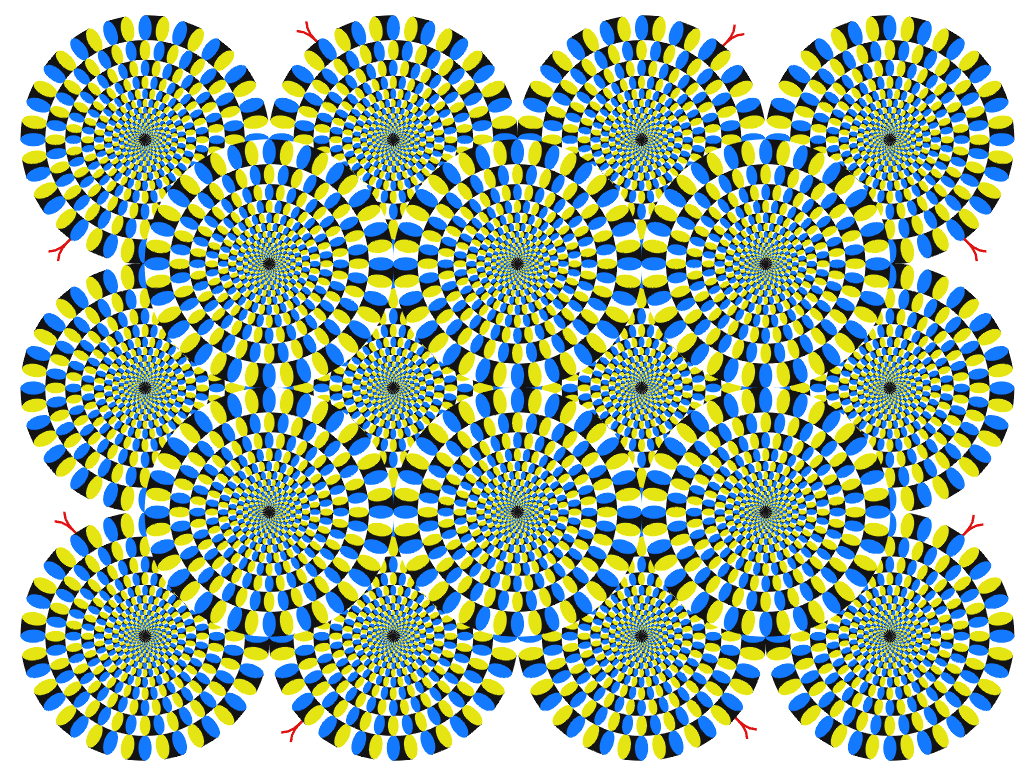
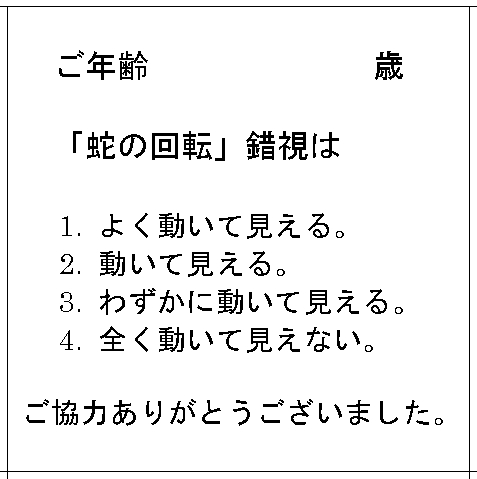
質問紙(調査票)
これまでの図示の様式に従うと、結果は下図の通りであった。183名のご協力を頂いた。この調査では、中学1年生向けの模擬講義のため、年齢は12歳と13歳に集中した。成人6人は引率の先生あるいはコーディネート担当の事務職員と考えられる。「蛇の回転」錯視と年齢の相関係数は、 r = .00 で、「蛇の回転」錯視の強さと年齢との間には、今回の調査では相関はなかった。年齢層が偏っていたので、当然の結果とも言える。
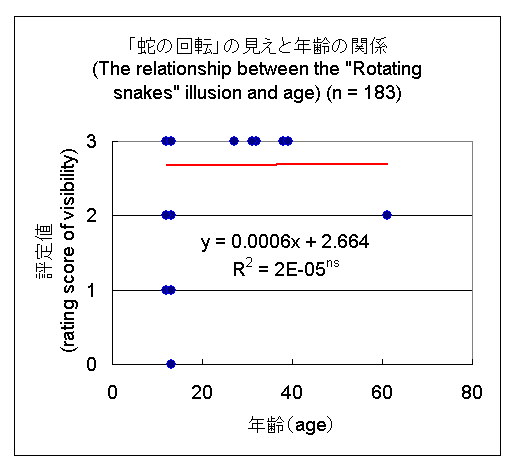
評定値3は「よく動いて見える」、2は「動いて見える」、1は「わずかに動いて見える」、0は「動いて見えない」である。
評定値の割合を示したのが下図である。成人のデータをはずし、中学1年生のデータのみの度数分布図である。大学生や高校生だけで調べたデータと比較すると、大体同じ傾向である。すなわち、4分の3程度が「よく動いて見え」、少数ながら「動いて見えない」人がいた。今回の標本の大きさは177と大きいことと、生徒さんが大変協力的であったことを考えると、このデータの信頼性は高いと考えられる。すなわち、若い人でもこの錯視が起きない人が少数いることがわかっていたが、その割合は2%程度(50人に1人)であることが、強く示唆された。
一方、過去のデータでは、60歳以上の高齢者では20%程度(5人に1人)であった。だからと言って、この錯視の見えと老化の間には関係があるとは言えない。現時点で言えることは、この錯視が見えない人は若年層から一定の割合で存在し、年齢が上がるとともにその割合は増加するが、高齢者でもこの錯視が見えない人は少数派のままにとどまる、という性質があるということである。また、この錯視が見えない人から、何らかの問題が報告されたことはないという事実も強調しておく必要がある。これに関連して、いわゆる色覚異常の方でこの錯視が見えない方が、色覚異常とこの錯視に何らかの関連性があるのではないかと示唆して下さったことがあったが、それはこの錯視が見えない人が年齢とともに増加することとは矛盾する(色覚異常は生得的な特性と考えられるので)。
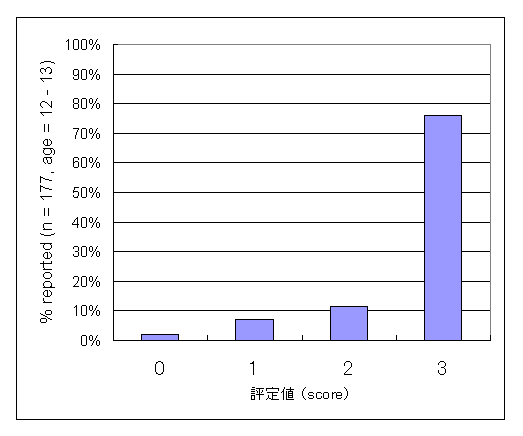
評定値3は「よく動いて見える」、2は「動いて見える」、1は「わずかに動いて見える」、0は「動いて見えない」である。
この錯視が見えなかった方へ。個人差ですので、心配しないで下さい。錯視が見えた方がたぶん面白いのですが、仕方ないです。私にも、言われている通りに見えない錯視があります。どうぞ、他の見える錯視を楽しんで下さい。
今回のデータに、全回のデータ(東京大学医学部の皆様)、全々回のデータ(静岡科学館る・く・るの来場者の皆様)、前々々回のデータ(「非線形数理東京フォーラム」の来場者の皆様)、前々々々回のデータ(立命館大学の情報処理心理学 I の受講生の皆様)、前々々々々回のデータ(仙台育英高校の皆様)、前々々々々々回のデータ(尼崎の高齢者の皆様)、前々々々々々々回のデータ(難波市民センターの皆様)、前々々々々々々々回のデータ(放送大学面接講義の皆様)を込みにすると、下図のようになった。若い人のデータで「よく動いて見える」と回答した人が多かったのと、高齢者に「動いて見えない」という回答が少なくなかったことから、「蛇の回転」錯視と年齢の相関係数は r = -.40 と絶対値がやや大きく、この相関は統計学的に有意(p < .01)であった。「若いとみんな見えて、トシを取ると見えなくなる」という関係にあるわけではないが、サンプル数が十分あると無視できない強さで逆相関が現れる(しかも、その年齢に関係した性質の強弱は生活の質にはまったく影響がない)。何を意味しているんだか・・・ 少なくとも、通常想定される老化(調節力低下や白内障など)とは関係がない。
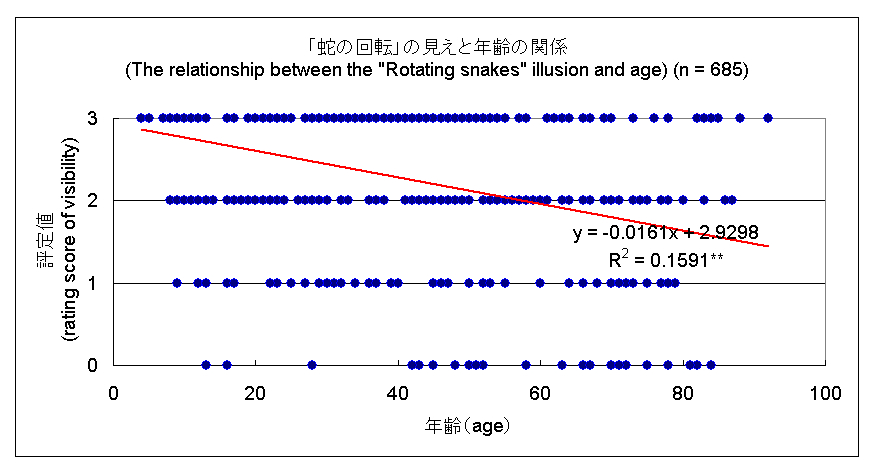
立命館慶祥中学校1年生の皆様、ご協力ありがとうございました。また、『蛇の回転』の錯視が見えないと報告してくれた4名の皆様、模擬講義では肩身の狭い思いをさせて申し訳なかったですが、ありがとうございました。貴重なデータとなります。4名の皆様はこの錯視が見えなくておもしろくないとは思いますが、練習によって見えるようになることは多分ありませんし(輝度の高いディスプレーで見ると見えることがあるらしいですが)、この錯視が見えないことで何か不都合があるわけではありませんので、これからはどうぞ別の見える錯視を楽しんで下さい。 <2008年3月6日>

何もしなくても動いて見える錯視のうち、フレーザー・ウィルコックス錯視系統のモデル化に成功するとともに、その基本要素を8つに分類した。
→ 黒・濃い灰色・白・薄い灰色という順番の繰り返しパターンは、あらゆるデザインで避ける必要がある。
(4) 錯視研究における新しい対人援助学的貢献について
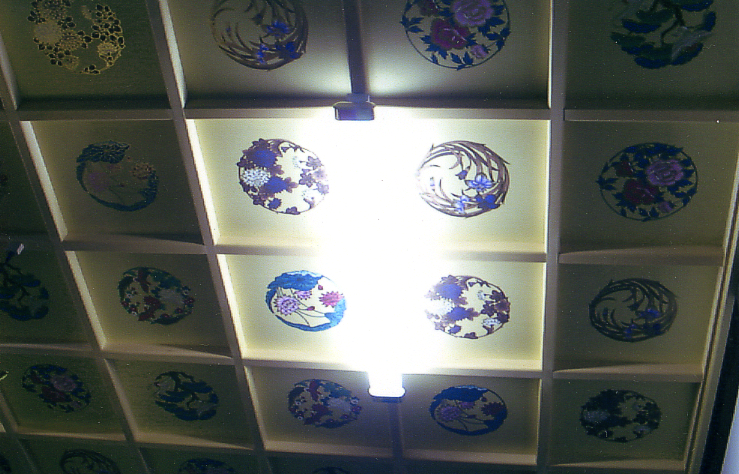
「願宗寺の錯視」
天井の蛍光灯をつけると、まっすぐなはずの横の桟が傾いて見える。具体的には、(1)蛍光灯部分が天井方向に引っ込んで見え、(2)蛍光灯の付いている桟と平行な(左右とも)2番目と3番目の桟をつなぐ横の桟も外側が天井方向に傾いて見える。
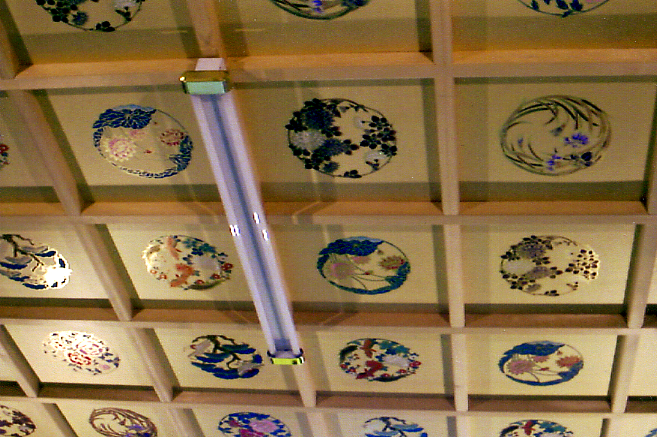
蛍光灯を消すと、これらの錯視は起きない。
2005年9月3日
Copyright Nishiwaki Osho 2005
この錯視は、新潟県上越市の願宗寺(浄土真宗本願寺派)にある。阿弥陀如来のお導きか。
北岡明佳のコメント: (1)は視覚的ファントムで桟の手前に面が知覚され、そのため奥行き対比が起きたものと私は考察する。(2)はブルドン錯視と考えられる。ブルドン錯視の実例の報告はひょっとして世界初ではないだろうか。

錯視研究は、錯視を病気ではないかと迷う人々に、それは錯視であるという正しい情報を与え、不要な心配や不安を取り除くことができる。
→ 精神科医との連携の下に、たとえば「錯視臨床インターネット相談室」を設置する試みは、対人援助学的であるかもしれない。
Thank you
まとめ 北岡明佳の今年度の成果はつぎのとおり。
1) 輝度コントラストが低いと知覚の質が低下する(見づらい)ことの重要な要因として、輝度コントラストが低いと脳内処理時間が長くなることを、実験的に示した。このことは、色コントラストが強くて一見視認性のよいデザインでも、輝度コントラストが低いと知覚しづらくなる、ということを示している。 → 色を多用する情報媒体のデザインにおいては、輝度コントラストにも細心の注意が必要である。
Kitaoka, A. and Ashida, H. (2007) A variant of the anomalous motion illusion based upon contrast and visual latency. Perception, 36, 1019-1035.
2) 斜線が起こす静止画が動いて見える錯視の重要な要因として、斜線の空間周波数特性と、斜線と網膜像スリップの方向の成す角の組み合わせであることを示した。 → 建築・内装等のデザインにおいては、できるだけ斜線を少なくするとともに、静止画が動いて見える錯視の発生しやすい刺激配置を避けることが必要である(たとえば、はっきりした長めの線分は、急な角度で交差させない)。
Kitaoka, A., and Murakami, I. (2007) Rotating Ouchi illusion [Abstract]. Journal of Vision, 7(9), 984a. (ポスター参照)
北岡明佳(監修) (2007) Newton別冊 脳はなぜだまされるのか? 錯視 完全図解 ニュートンプレス (ポスター参照)
3) 何もしなくても動いて見える錯視のうち、フレーザー・ウィルコックス錯視系統のモデル化に成功するとともに、その基本要素を8つに分類した。 → 黒・濃い灰色・白・薄い灰色という順番の繰り返しパターンは、あらゆるデザインで避ける必要がある。
Murakami, I., Kitaoka, A. and Ashida, H. (2006) A positive correlation between fixation instability and the strength of illusory motion in a static display. Vision Research, 46, 2421-2431
Kitaoka, A. (2007) Phenomenal classification of the “optimized” Fraser-Wilcox illusion and the effect of color. Poster presentation in DemoNight, VSS2007, GWiz, Sarasota, Florida, USA, May 14, 2007. (ポスター参照)